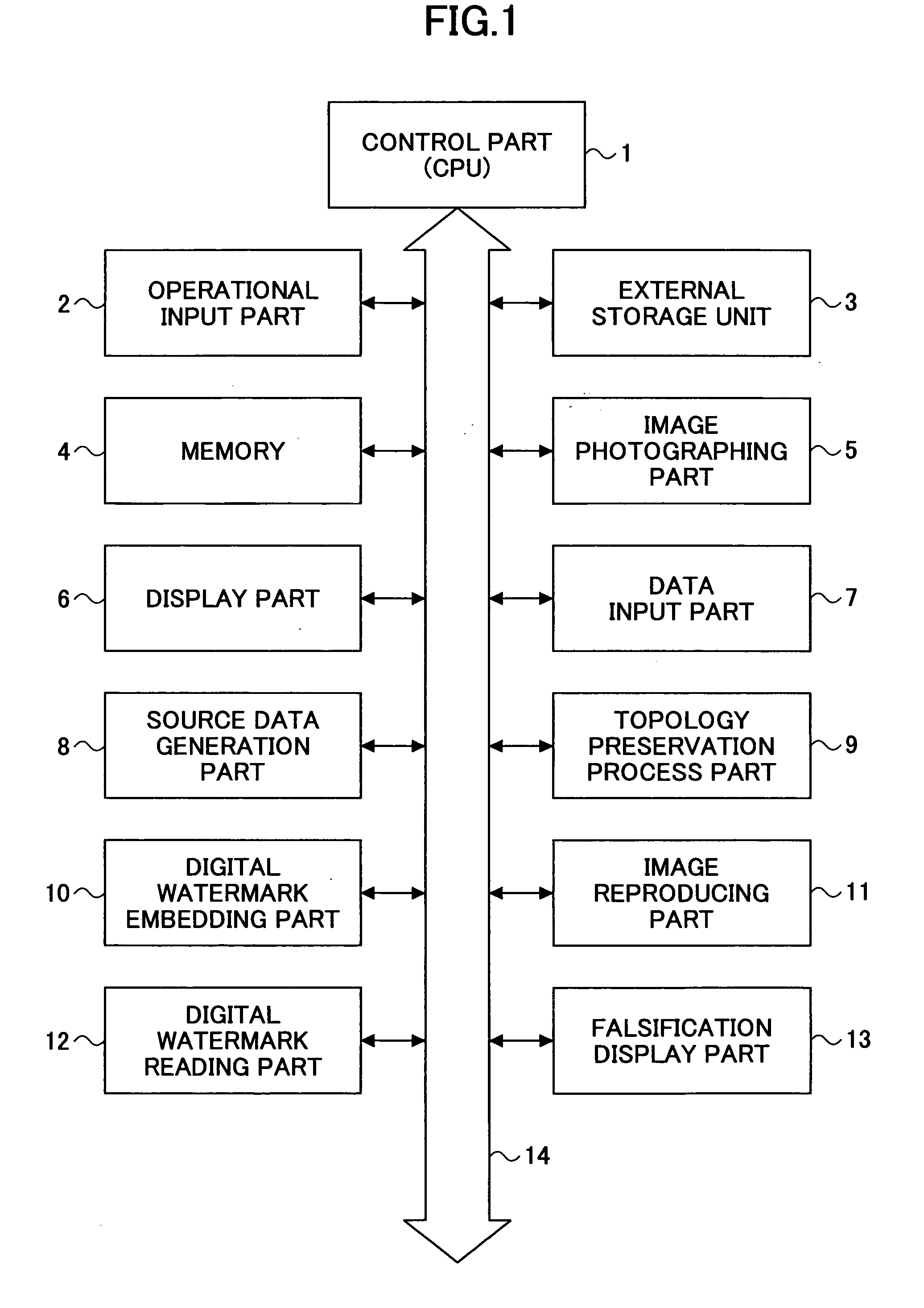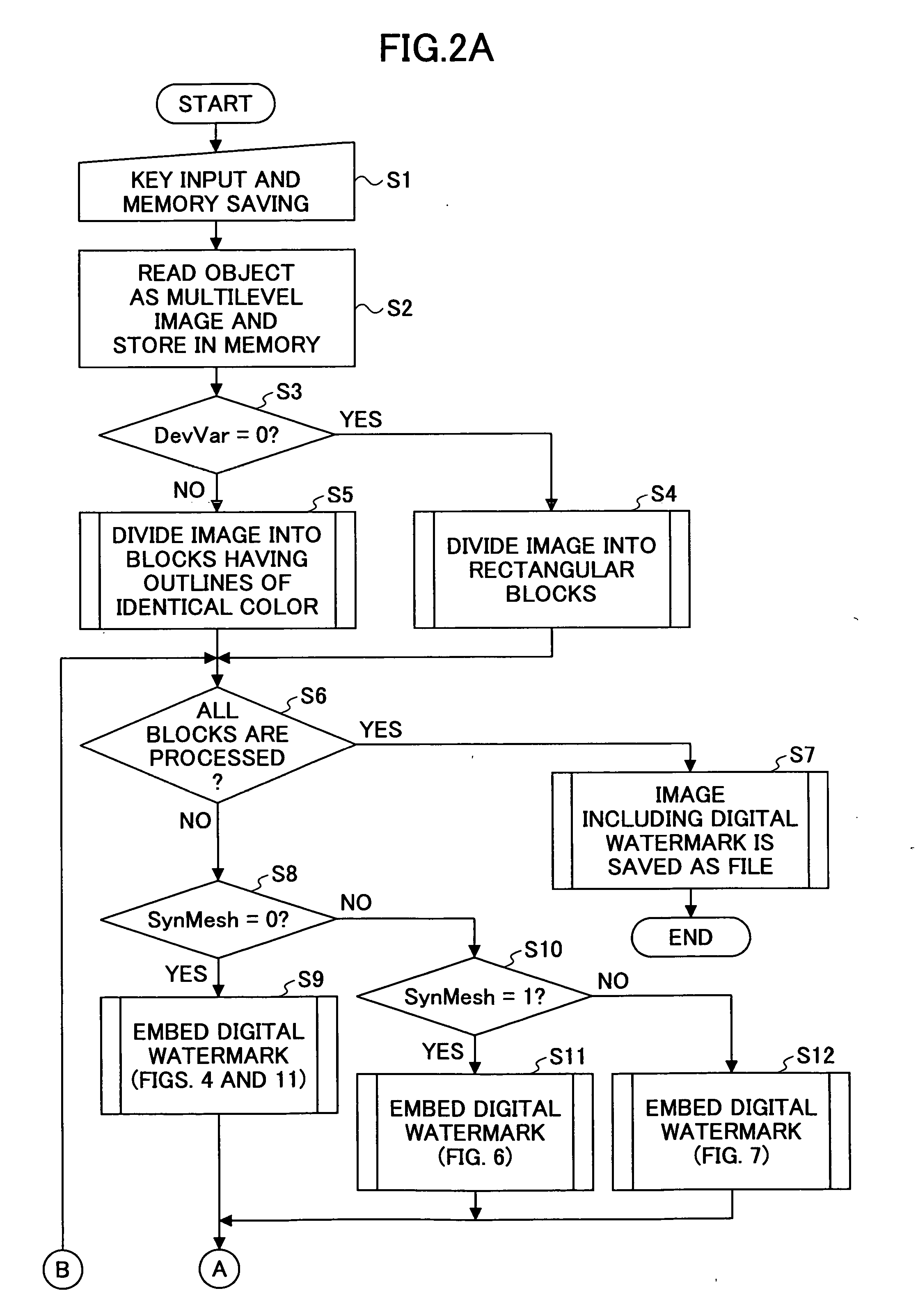Image processing method, image processing apparatus, program and recording medium that can reduce image quality degradation
a technology of image quality and image processing method, applied in the field of image processing method, image processing apparatus, programs, and recording media, can solve the problems of digital information being easily overwritten and/or falsified, digital information being likely to be illegally copied and reused, and digital information cannot be used, so as to achieve the effect of reducing image quality degradation
- Summary
- Abstract
- Description
- Claims
- Application Information
AI Technical Summary
Benefits of technology
Problems solved by technology
Method used
Image
Examples
first embodiment
[0096]FIGS. 4A, 4B and 4C are diagrams for illustrating digital watermark embedding according to the present invention. Referring to FIGS. 4A, 4B and 4C, a description is given of topology preservation rules in the case of embedding a digital watermark in the same line.
[0097] In FIG. 4A, (a) represents an original image, (b) represents-the image embedding therein a digital watermark, and circles (◯) shown in the bottom of the figure indicate whether a topology conservation law is satisfied (◯ indicates “YES”). FIG. 4A-(a) represents a unit of run-length of image data of one line quantized by, for example, 8 bits. That is, the run-length shown in FIG. 4A-(a) consists of run-lengths of four kinds of colors, i.e., a run-length a (e.g., having the length of 5 pixels and each pixel value is 100), a run-length b (e.g., having the length of 1 pixel and the pixel value is 0), a run-length c (e.g., having the length of 5 pixels and each pixel value is 255), and a run-length d (the length of ...
second embodiment
[0116]FIG. 5 is a diagram for illustrating digital watermark embedding according to a Referring to FIG. 5, a description is given of a digital watermark embedding method that preserves topology in block boundary portions.
[0117] In the case where a block boundary portion exists between run-lengths C and C′ (each having a length of one pixel) of Line 1 (indicated by (a) in FIG. 5) of an original image, since the run-lengths C and C′ are of an identical color, even if one of the run-lengths C and C′ is deleted, the topology is preserved and a valid digital watermark embedding process may be performed. One of the run-lengths C and C′ may be deleted by extending a run-length B for one pixel to delete the run-length C or by extending a run-length D for one pixel to delete the run-length C′. Alternatively, a process may be performed that allows extension of the run-length C or C′ for one pixel without performing the above-mentioned deletion of the run-length C or C′ by not assuming the ru...
third embodiment
[0119]FIG. 6 is a diagram for illustrating digital watermark embedding according to a Referring to FIG. 6, a description is given of a digital watermark embedding method that preserves topology between the adjacent lines stacked on one another. In FIG. 6, (a) represents the original images of two lines, i.e., Line 1 and Line 2, and (b) represents a case where a digital watermark is valid. Although the run-length C of Line 1 is extended for one pixel, the continuity between the run-length C of the Line 1 and the run-length d of Line 2 is maintained (the topology is preserved). It should be noted that, in FIG. 6, the lengths of the run-lengths A, B, a, b, c and e are not changed for simplicity of explanation.
[0120] On the other hand, (c) represents the case where the run-length c of Line 2 and the run-length D of Line 1 are extended for one pixel. In this case, the run-lengths C and d are not continuous, which is different from the original image (a). Thus, the topology is not preser...
PUM
 Login to View More
Login to View More Abstract
Description
Claims
Application Information
 Login to View More
Login to View More - R&D
- Intellectual Property
- Life Sciences
- Materials
- Tech Scout
- Unparalleled Data Quality
- Higher Quality Content
- 60% Fewer Hallucinations
Browse by: Latest US Patents, China's latest patents, Technical Efficacy Thesaurus, Application Domain, Technology Topic, Popular Technical Reports.
© 2025 PatSnap. All rights reserved.Legal|Privacy policy|Modern Slavery Act Transparency Statement|Sitemap|About US| Contact US: help@patsnap.com



